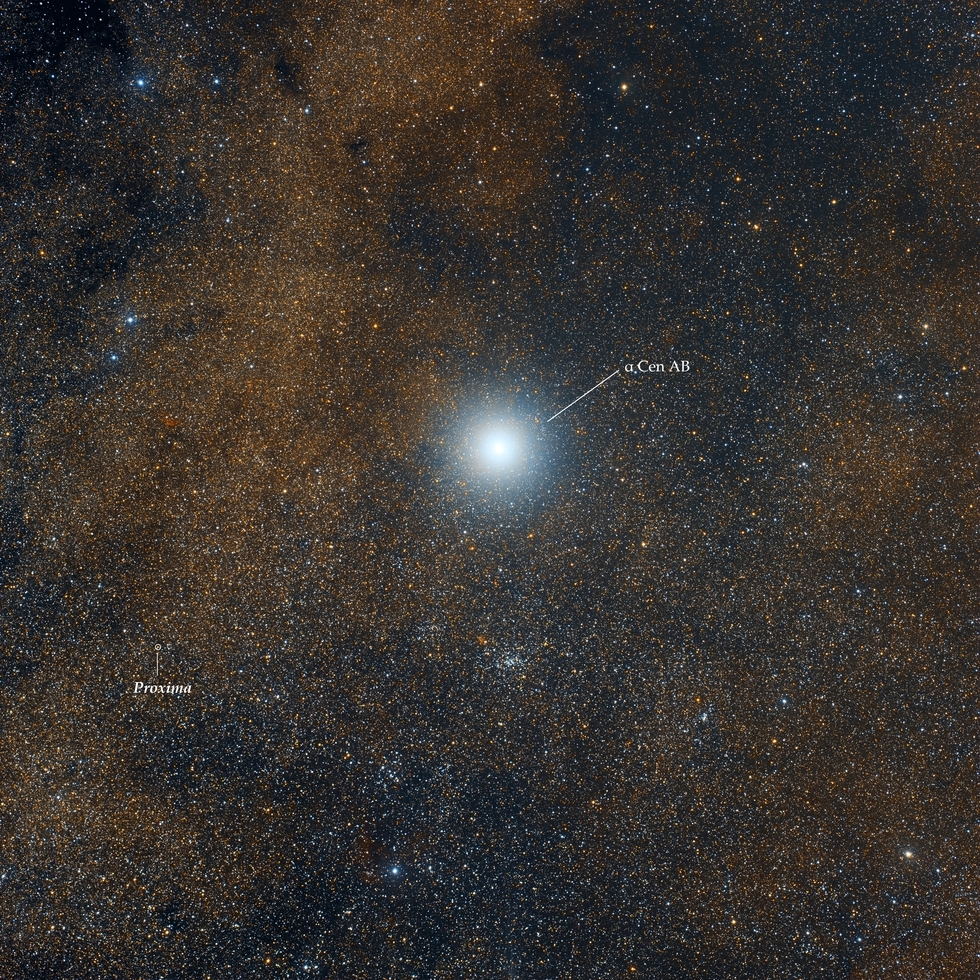Alpha Centauri
Alpha Centauri
Our closest stellar neighbor, Alpha Centauri, shines bright at the front feet of the Centaurus, being the third brightest star in the whole night sky, after Sirius and Canopus. To the naked eye, this looks like a single star but is actually made of 3 stars – Rigil Kentaurus (α Centauri A), Toliman (α Centauri B), and Proxima Centauri (α Centauri C). Proxima is not visible to the naked eye but from the 3 stars, it sits closest to the Sun at 4,2465 light-years.
Rigil Kentaurus is a latinisation for the Arabic term for “the foot of the Centaur”, while Toliman is an approximate translation from the Arabic for “the two male ostriches”, reference to an ancient asterism of which Alpha Centauri was part of. Proxima Centauri was discovered in 1915 by Robert Innes by blinking photographic plates taken at different times. He noticed a similar parallax to Alpha Centauri AB and concluded that Proxima is part of this system as well.
The binary nature of Alpha Centauri AB was noticed for the first time in 1689 by Jean Richaud, while observing a passing comet. AT the time, it was only the third double star to be discovered, after Mizar AB and Acrux. The large proper motion of Alpha Centauri AB was discovered by Manuel Johnson, observing from Saint Helena, who was in touch with Thomas Henderson at the Royal Observatory in Cape of Good Hope. Henderson determined the parallax of the doublet in 1833 but withheld his calculations because he thought the value was too high. Finally, he published the values in 1839 after Bessel released his calculations for 61 Cygni in 1838.
The current value for proper motion is 3686 milliarcseconds/year towards NW. The relative speed of the system is 22.4 km/s towards the Solar System. These values combined mean that in approximately 4.000 years, Alpha Centauri AB will come apparently close to Hadar (Beta Centauri), then it will move north of Crux and in about 24.000 years, it will reach its minimum distance from the Sun, at 2,9 light-years, being in the constellation of Hydra. At this time, it will have an apparent magnitude of -0,86.
Seen from this system, the Sun would have an apparent magnitude of +0,5 and it would be located in Cassiopeia. Sirius would be located very close (1°) to Betelgeuse and Procyon would find itself in the middle of Gemini.
Rigil Kentaurus and Toliman are stars very similar to the Sun, with the former being slightly larger and hotter than the Sun, while the latter is smaller and cooler. Their orbital period is 79,7 years and they come as close as 11,2 AU (Sun-Saturn distance) and farthest at 35,6 AU (Sun-Pluto distance). Proxima is located currently at 13.000 AU from the main pair with an orbital period of 511.000 years. It can come as close as 4.100 AU from Alpha Centauri AB.
Proxima is a red dwarf (spectral class M5Ve) having only 12% of the Sun’s mass and 15% of its radius. Its apparent magnitude is a mere +10,5 and it radiates more than 85% of its power in the infrared. Because of its size, Proxima’s interior is entirely convective, meaning that the star will completely exhaust its hydrogen supply in its lifetime, compared to the Sun, which will consume just 10% of the hydrogen before leaving the main sequence. The stellar flares of Proxima are much stronger than the Sun’s, growing as large as the star itself and reaching temperatures of 27 million K, hot enough to radiate X-rays.
Proxima has 3 exoplanets around them, discovered in 2016, 2020 and 2022, two of them being Earth-sized and the other one either a super-Earth or a mini-Neptune.
Rigil Kentaurus is a latinisation for the Arabic term for “the foot of the Centaur”, while Toliman is an approximate translation from the Arabic for “the two male ostriches”, reference to an ancient asterism of which Alpha Centauri was part of. Proxima Centauri was discovered in 1915 by Robert Innes by blinking photographic plates taken at different times. He noticed a similar parallax to Alpha Centauri AB and concluded that Proxima is part of this system as well.
The binary nature of Alpha Centauri AB was noticed for the first time in 1689 by Jean Richaud, while observing a passing comet. AT the time, it was only the third double star to be discovered, after Mizar AB and Acrux. The large proper motion of Alpha Centauri AB was discovered by Manuel Johnson, observing from Saint Helena, who was in touch with Thomas Henderson at the Royal Observatory in Cape of Good Hope. Henderson determined the parallax of the doublet in 1833 but withheld his calculations because he thought the value was too high. Finally, he published the values in 1839 after Bessel released his calculations for 61 Cygni in 1838.
The current value for proper motion is 3686 milliarcseconds/year towards NW. The relative speed of the system is 22.4 km/s towards the Solar System. These values combined mean that in approximately 4.000 years, Alpha Centauri AB will come apparently close to Hadar (Beta Centauri), then it will move north of Crux and in about 24.000 years, it will reach its minimum distance from the Sun, at 2,9 light-years, being in the constellation of Hydra. At this time, it will have an apparent magnitude of -0,86.
Seen from this system, the Sun would have an apparent magnitude of +0,5 and it would be located in Cassiopeia. Sirius would be located very close (1°) to Betelgeuse and Procyon would find itself in the middle of Gemini.
Rigil Kentaurus and Toliman are stars very similar to the Sun, with the former being slightly larger and hotter than the Sun, while the latter is smaller and cooler. Their orbital period is 79,7 years and they come as close as 11,2 AU (Sun-Saturn distance) and farthest at 35,6 AU (Sun-Pluto distance). Proxima is located currently at 13.000 AU from the main pair with an orbital period of 511.000 years. It can come as close as 4.100 AU from Alpha Centauri AB.
Proxima is a red dwarf (spectral class M5Ve) having only 12% of the Sun’s mass and 15% of its radius. Its apparent magnitude is a mere +10,5 and it radiates more than 85% of its power in the infrared. Because of its size, Proxima’s interior is entirely convective, meaning that the star will completely exhaust its hydrogen supply in its lifetime, compared to the Sun, which will consume just 10% of the hydrogen before leaving the main sequence. The stellar flares of Proxima are much stronger than the Sun’s, growing as large as the star itself and reaching temperatures of 27 million K, hot enough to radiate X-rays.
Proxima has 3 exoplanets around them, discovered in 2016, 2020 and 2022, two of them being Earth-sized and the other one either a super-Earth or a mini-Neptune.
SPECIFICATIONS
Telescope
Takahashi FSQ-106ED f/3,6
Camera
FLI PL16803
Location
Heaven's Mirror Observatory, Australia
Date of observation
02.06.2025
Filters
LRGB
Processing
PixInsight



